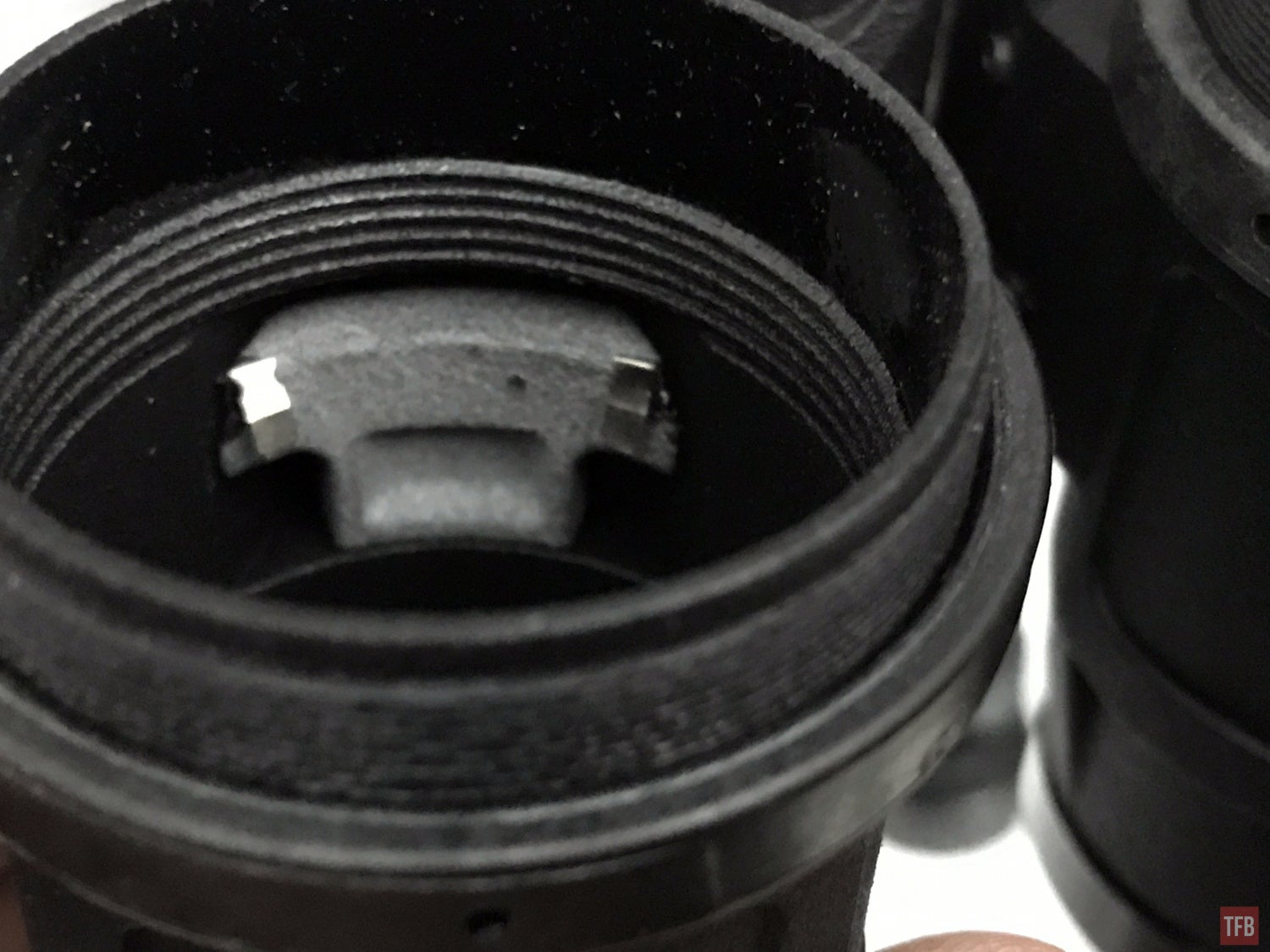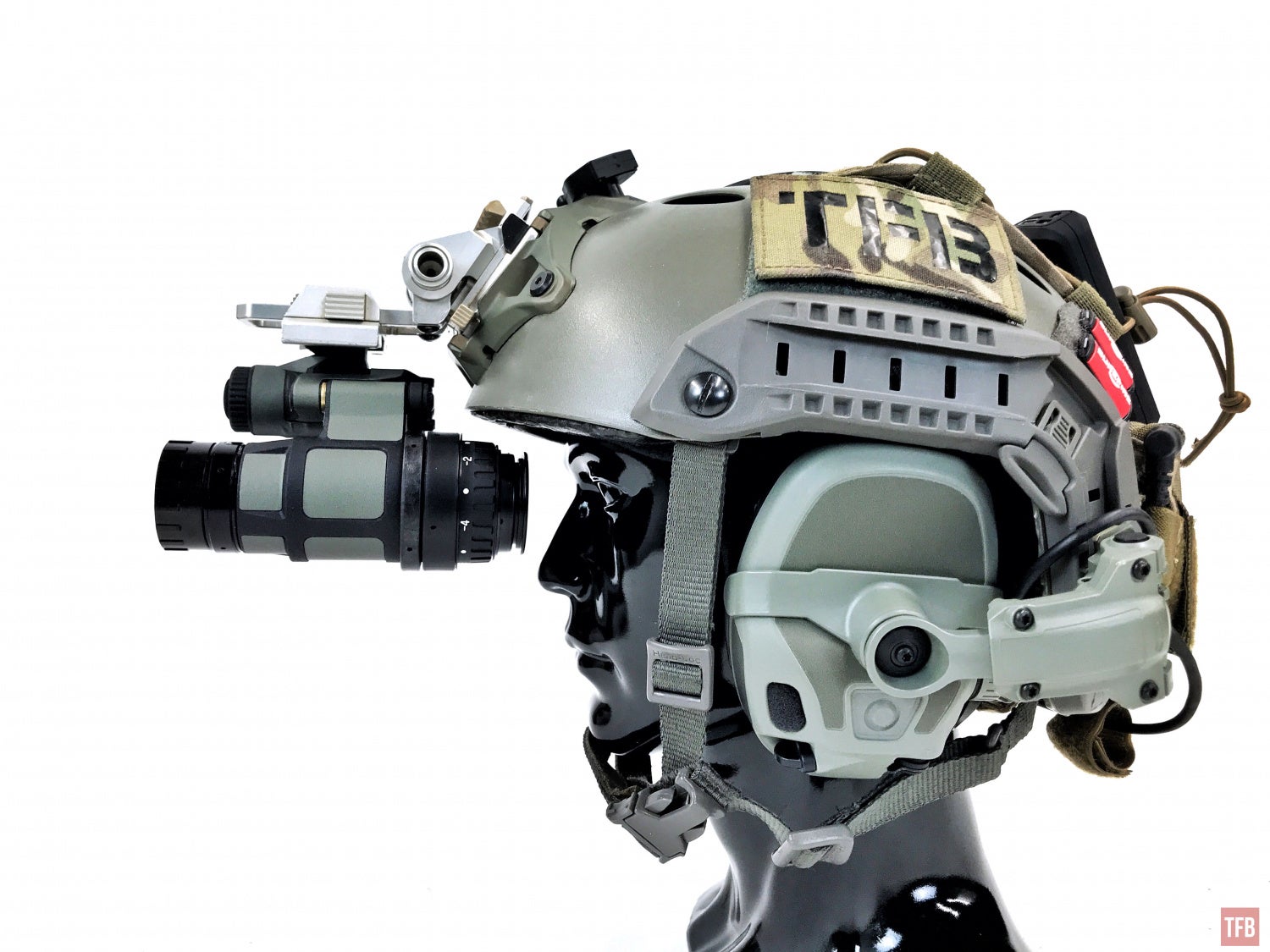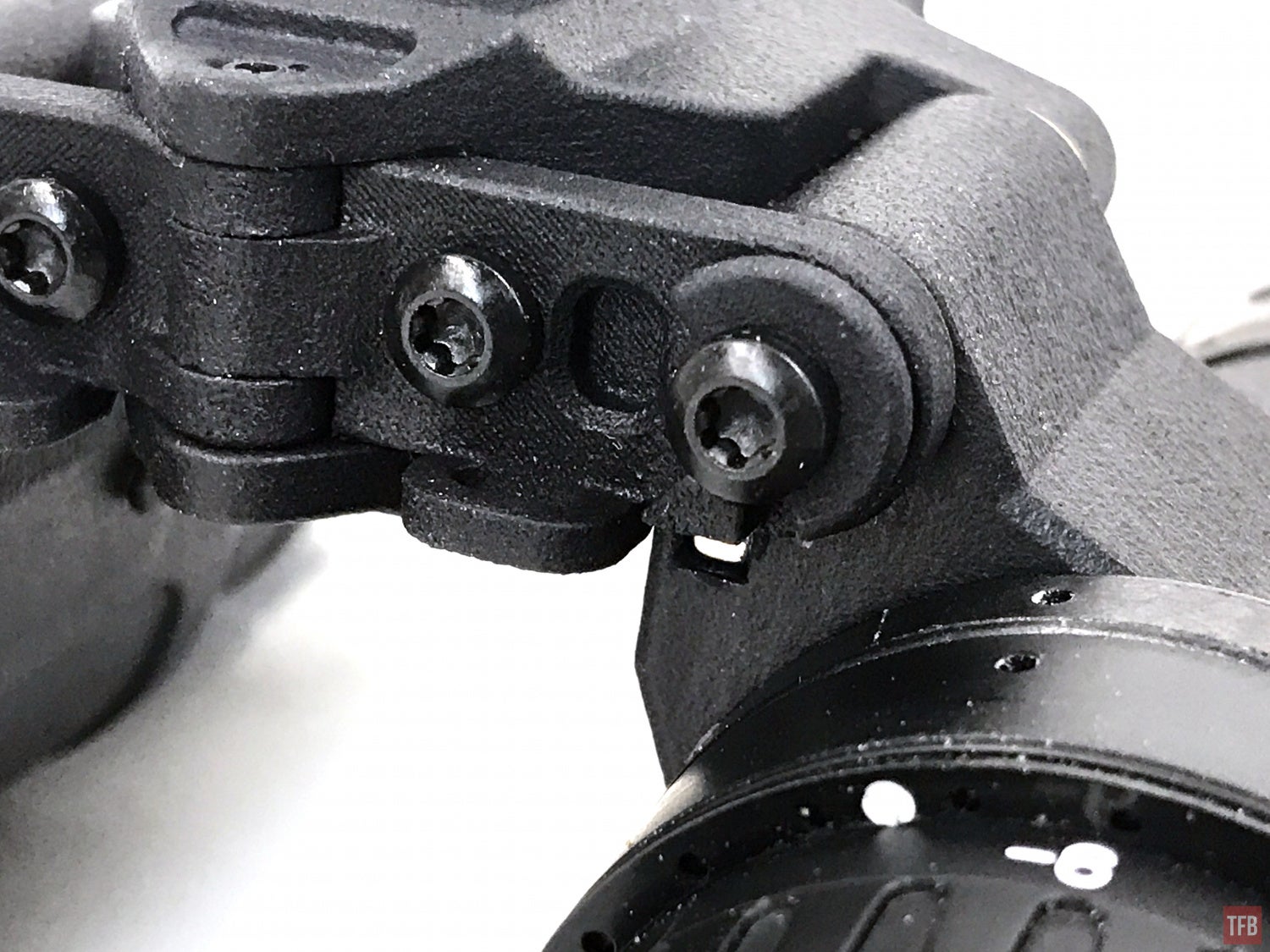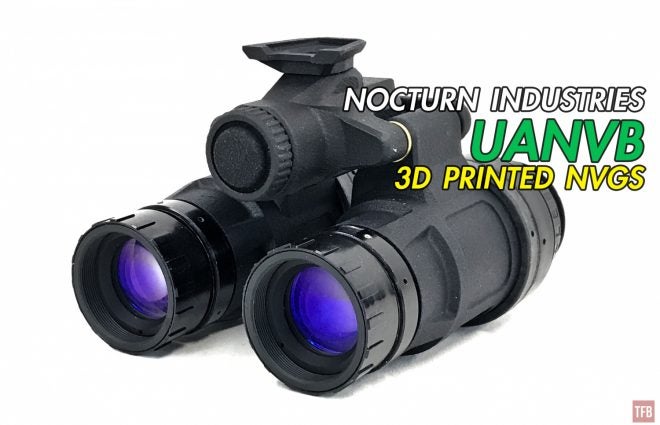On this week’s edition of Friday Night Lights, we bring you another Dual Tube Spotlight. This is where we review a binocular night vision goggle. This time we are looking at a newcomer to the night vision scene, Nocturn Industries. They are coming out with a 3D printed dual tube night vision binocular called the UANVB Katana.
Night Vision Newcomer: Nocturn Industries

Photo by Nocturn Industries.
The brains behind Nocturn Industries is Jeffery Melochick. You may recall he was the one converting Gen2 PVS-5s (Ghostbusters goggles) into articulating binos. He calls them the PVS5-31. Jeffery is actually an R&D engineer for a major firearm manufacturer. He has a business partner named Nick Berube. Nick, not me, is a contributing designer on their new UANVB (Ultralight Articulating Night Vision Binocular). Which they colloquially call the Katana.
What separates the UANVB from other night vision devices is that this one is 3D printed.

Preproduction packaging and Nocriunm wraps.

Jeffery’s goal with his UANVB housing is to chase after the king of lightweight articulating binos, the PVS-31A by L3Harris. The PVS-31A weighs 15.5 ounces or 439.4 grams. Below is the weight of the UANVB housing with infinite focus stops, and eyepiece lock rings.
Close Look At The UANVB

4.33 ounces

To try and compare something similar, here is the BNVD-1431 which is 7.02 oz.
Now the UANVB is 3D printed but that is just the housing itself. Nocturn Industries is using additive manufacturing rather than traditional milling or injection molding. While he can get some interesting geometry, it is still an electro-optic and it needs wiring, electrical contacts and a battery tube with a switch. These cannot be 3D printed into the housing and need to be installed by Nocturn Industries.

I am sure some of you reading this are thinking to yourselves: “3D printing? That will be too brittle!” That may be true with your typical DIY garage/desktop 3D printers that use FDM (Fused Deposition Modeling). Nocturn Industries is using MJF (Multi Jet Fusion) printing which Jeffery stands behind. Our very own Giorgio O is well versed in 3D printing technology and confirms Jeffery’s claims that this is a robust material and not prone to the same failures that FDM and other 3D printing methods have.

The threads for the eyepieces are printed rather than machined into the housing.
While Jeffery has to keep the external threads the same spec as other night vision housings, he is free to change the inner threads for the tube retaining ring. See the gray 3D printed ring?

Jeffery made these threads extra course in comparison to traditional tube retaining ring threads. This makes it easier to install the tube retaining ring. Also less chance the ring or the housing threads can be stripped.

UANVB tube retaining ring threads.
Here is Nocturn Industries tube retaining ring on the left with a normal PVS-14 style tube retaining ring on the right. You can see how much bigger the threads are on the Nocturn Industries ring.


BNVD-1431 tube retaining ring threads.
Nocturn Industries included a tube retaining ring instal tool that is also 3D printed.

Nocturn Industries tube retaining ring tool next to PVS-14 tube retaining ring tool.
The UANVB is powered by a single CR123. The battery cap houses a simple button switch that you press to turn on and press it again to turn it off.



This preproduction sample has some screws that are not countersunk.








The UANVB has built-in interpupillary distance stops. See the semicircular part underneath the outer screws?


The IPD stops are friction-based which makes them very simple to adjust and set.
Part of the rear plate are loops to hook your helmet bungees or a lanyard.


Built UANVBs weigh just 19.47 ounces.

BNVD-1431 built weigh 22.75 ounces.
Benefits Of On-Demand 3D Printing
So the huge benefit to 3D printing the UANVB is that initial costs are very low. No need for tooling or a mold with traditional manufacturing processes. If Nocturn Industries needs to make adjustments to the design of their UANVB housing, they are flexible and can produce a functioning goggle in a much shorter time and all it cost was to print another housing.
The preproduction UANVB they sent me had a few minor issues. No deal breakers but areas in which it could be improved upon. The exposed screws under the arm are a bit of an eyesore and since they are not countersunk they snag when you touch them. The boot of the battery cap switch is 3D printed and while it is flexible, it is still rather stiff. The UANVB features a magnetic reed switch similar to the DTNVG housing. When the pods articulate away from the central body, power is automatically turned off to the image intensifier tube. This sample had installed the magnets inside the central body. While it still functions, it would occasionally attract the CR123 battery preventing it from sliding out due to gravity.
After I gave Jeffery feedback he made an updated housing.


The new rubber switch boot looks like the window of Tie Fighter. Also, he added structural ribs on the front leading face of the articulating arms.
He switched from a 3D printed rubber switch boot to a rubber boot used for flashlights. Now turning the UANVB on or off is much easier.

Below is a side-by-side comparison to the first UANVB housing I was sent and the new updated version.

Tha large pan head screws are for purging each pod.

Jeffery removed the panel and screws completely under the articulating arms.

The bottom access panel has changed geometry and he is using countersunk screws.

See the white/silver looking hole below the IPD stop and screw? That is a rare earth magnet that helps turn the power off to the tubes when the pods are rolled out of the way.
In the first preproduction sample, Nocturn Industries had applied a new surface finish to the inside of the monocular pods. This was to help create a better seal for both watertightness and nitrogen purge. However, it was a hair too tight. The friction on the objective lenses was a bit too tight making it a little difficult to adjust focus. So I set them to infinite focus. I had told this to Jeffery and they applied a new surface finish to the new UANVB housing and no more issues.

UANVB Final Report
The Multijet Fusion printing results in a very robust and strong material. Nocturn Industries has performed multiple NATO 1.5 meter drop tests of their housing against competitor housings. The UANVB handled it just fine. The other competitor housing broke from the impact. They have shown me these videos but unfortunately, they are not published so I cannot share them. They do have a video showing a purge test on their housing.
I am not sure what they are doing differently but I was unable to get their alleged 17.67 ounce system weight with battery. My build uses aluminum infinite focus stops and aluminum eyecup retaining rings. The focus stop is for use with a COTI mount and the eyecup retaining ring is to mount an LPMR POV camera. I like the UANVB as it functions very similar to a DTNVG. I prefer a magnetic reed switch to shut power to the tubes when the pods are rolled out of the way. The BNVD1431 shuts off when the goggle is oriented past vertical. But the pods do not shut off just because you roll them out of the way. That is one of the biggest drawbacks to that design. As I said the UANVB function is similar to a DTNVG just no onboard IR illuminator. They saved weight by not going with a traditional rotary switch. Best part? The housing is about $1,000 cheaper than the DTNVG at retail prices.
The UANVB is a small step into Nocturn Industries’ direction of night vision. They have a lot more ideas coming up and they are offering a lifetime warranty on their housing.
Warranty: Lifetime repair of all housing components no questions asked. (Does not cover damages to intensifier tubes or lense assemblies)
Next up are some ultra-lightweight lenses by Rochester Precision Optics. If the alleged weights of the lenses are accurate, they predict a 15.5 oz complete build weight with IPD stops and battery. That is very similar to PVS-31A. I have some of these lenses on order and will be seeing how much they can really drop the weight of various night vision goggles. But until that happens you can go to Nocturn Industries website for more information about their UANVB. Right now they are running a pre-order sale for $1499. After it launches, the regular price for the housing will be $1699.
 Your Privacy Choices
Your Privacy Choices
